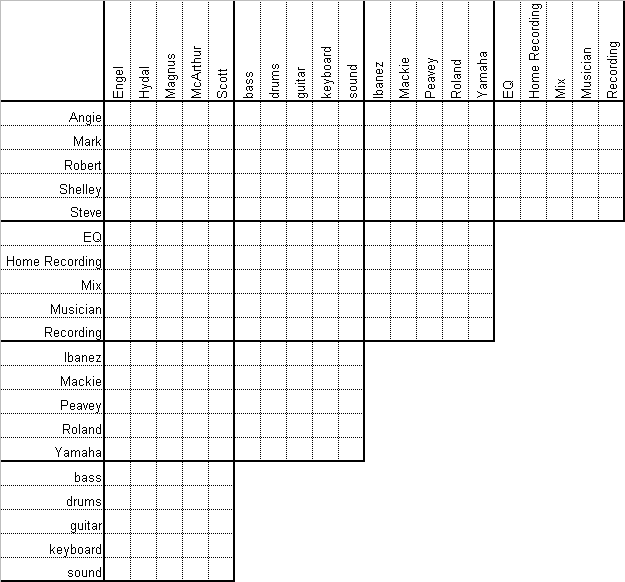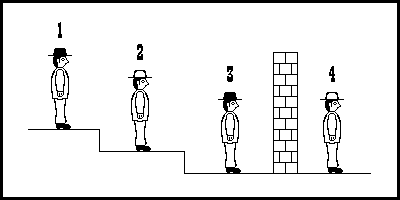Hard Puzzles
-
Five friends pooled their resources one day and pieced a CD together from songs they had written. They called their band “The Puzzle Fry” and ended up playing a number of live gigs at local events. Determine the full name of each band member, the instrument (or mixing console) each played, the brand of equipment each used, plus each member’s favorite magazine.
- Steve wasn’t the sound engineer. One of the women enjoyed EQ magazine.
- Angie and Steve didn’t like Recording magazine. The bass player used Ibanez equipment.
- Mr. Magnus didn’t use Mackie equipment. Mark’s last name wasn’t Hydal and he didn’t play keyboard.
- The sound engineer, whose last name wasn’t Engel, enjoyed reading Mix magazine. The person who used Yamaha drums wasn’t Robert, but their last name is Hydal.
- The five band members (in no particular order) were: Mark Scott, the female bass player, the person who read Musician, the one who used Peavey equipment, and Robert.
- Shelley’s last name was not Hydal or McArthur and she didn’t use Roland equipment. Mackie only developed equipment for live sound and recording NOT musical instruments.
- Steve McArthur was the guitarist.
Use the grid to help solve the puzzle!
 View SolutionSubmit Solution
View SolutionSubmit Solution- 1,445.6K views
- 1 answers
- 1 votes
-
Imagine that you’re about to set off walking down a street. To reach the other end, you’d first have to walk half way there. And to walk half way there, you’d first have to walk a quarter of the way there. And to walk a quarter of the way there, you’d first have to walk an eighth of the way there. And before that a sixteenth of the way there, and then a thirty-second of the way there, a sixty-fourth of the way there, and so on.
Ultimately, in order to perform even the simplest of tasks like walking down a street, you’d have to perform an infinite number of smaller tasks—something that, by definition, is utterly impossible. Not only that, but no matter how small the first part of the journey is said to be, it can always be halved to create another task; the only way in which it cannot be halved would be to consider the first part of the journey to be of absolutely no distance whatsoever, and in order to complete the task of moving no distance whatsoever, you can’t even start your journey in the first place.
View SolutionSubmit Solution- 1,445.6K views
- 1 answers
- 0 votes
-
A crocodile snatches a young boy from a riverbank. His mother pleads with the crocodile to return him, to which the crocodile replies that he will only return the boy safely if the mother can guess correctly whether or not he will indeed return the boy. There is no problem if the mother guesses that the crocodile will return him—if she is right, he is returned; if she is wrong, the crocodile keeps him. If she answers that the crocodile will not return him, however, we end up with a paradox: if she is right and the crocodile never intended to return her child, then the crocodile has to return him, but in doing so breaks his word and contradicts the mother’s answer. On the other hand, if she is wrong and the crocodile actually did intend to return the boy, the crocodile must then keep him even though he intended not to, thereby also breaking his word.
The Crocodile Paradox is such an ancient and enduring logic problem that in the Middle Ages the word “crocodilite” came to be used to refer to any similarly brain-twisting dilemma where you admit something that is later used against you, while “crocodility” is an equally ancient word for captious or fallacious reasoning
View SolutionSubmit Solution- 1,447.9K views
- 1 answers
- 0 votes
-
Imagine you’re holding a postcard in your hand, on one side of which is written, “The statement on the other side of this card is true.” We’ll call that Statement A. Turn the card over, and the opposite side reads, “The statement on the other side of this card is false” (Statement B). Trying to assign any truth to either Statement A or B, however, leads to a paradox: if A is true then B must be as well, but for B to be true, A has to be false. Oppositely, if A is false then B must be false too, which must ultimately make A true.
Invented by the British logician Philip Jourdain in the early 1900s, the Card Paradox is a simple variation of what is known as a “liar paradox,” in which assigning truth values to statements that purport to be either true or false produces a contradiction. An even more complicated variation of a liar paradox is the next entry on our list.
Submit Solution- 1,446.7K views
- 0 answers
- -1 votes
-
Imagine that a family has two children, one of whom we know to be a boy. What then is the probability that the other child is a boy? The obvious answer is to say that the probability is 1/2—after all, the other child can only be either a boy or a girl, and the chances of a baby being born a boy or a girl are (essentially) equal. In a two-child family, however, there are actually four possible combinations of children: two boys (MM), two girls (FF), an older boy and a younger girl (MF), and an older girl and a younger boy (FM). We already know that one of the children is a boy, meaning we can eliminate the combination FF, but that leaves us with three equally possible combinations of children in which at least one is a boy—namely MM, MF, and FM. This means that the probability that the other child is a boy—MM—must be 1/3, not 1/2.
View SolutionSubmit Solution- 1,447.1K views
- 1 answers
- 0 votes
-
The Bootstrap Paradox is a paradox of time travel that questions how something that is taken from the future and placed in the past could ever come into being in the first place. It’s a common trope used by science fiction writers and has inspired plotlines in everything fromDoctor Who to the Bill and Ted movies, but one of the most memorable and straightforward examples—by Professor David Toomey of the University of Massachusetts and used in his book The New Time Travellers—involves an author and his manuscript.
Imagine that a time traveller buys a copy of Hamlet from a bookstore, travels back in time to Elizabethan London, and hands the book to Shakespeare, who then copies it out and claims it as his own work. Over the centuries that follow, Hamlet is reprinted and reproduced countless times until finally a copy of it ends up back in the same original bookstore, where the time traveller finds it, buys it, and takes it back to Shakespeare. Who, then, wrote Hamlet?
View SolutionSubmit Solution- 1,446.7K views
- 1 answers
- 0 votes
-
The Paradox of Achilles and the Tortoise is one of a number of theoretical discussions of movement put forward by the Greek philosopher Zeno of Elea in the 5th century BC. It begins with the great hero Achilles challenging a tortoise to a footrace. To keep things fair, he agrees to give the tortoise a head start of, say, 500m. When the race begins, Achilles unsurprisingly starts running at a speed much faster than the tortoise, so that by the time he has reached the 500m mark, the tortoise has only walked 50m further than him. But by the time Achilles has reached the 550m mark, the tortoise has walked another 5m. And by the time he has reached the 555m mark, the tortoise has walked another 0.5m, then 0.25m, then 0.125m, and so on. This process continues again and again over an infinite series of smaller and smaller distances, with the tortoise always moving forwards while Achilles always plays catch up.
Logically, this seems to prove that Achilles can never overtake the tortoise—whenever he reaches somewhere the tortoise has been, he will always have some distance still left to go no matter how small it might be. Except, of course, we know intuitively that he can overtake the tortoise. The trick here is not to think of Zeno’s Achilles Paradox in terms of distances and races, but rather as an example of how any finite value can always be divided an infinite number of times, no matter how small its divisions might become.
View SolutionSubmit Solution- 1,446.9K views
- 1 answers
- 0 votes
-
- 1,444.7K views
- 1 answers
- 0 votes
-
Below are thirteen 5 lettered, everyday words, each of which has had two of its letters removed.
In total these 26 letters are A-Z. The remaining letters in each word are in the correct order.
There are no words which are spelled differently based upon location (favour/favor, etc) and there are no plurals.
Can you determine the original words?
APE
BAE
BOD
ANC
ROE
ELL
RAY
BUC
ORA
UMB
SUA
LOL
GES View SolutionSubmit Solution
View SolutionSubmit Solution- 1,448.1K views
- 1 answers
- 0 votes
-

Naga a safari in the kajiranga jungle capture three men. The naga give the men a single chance to escape uneaten.
The prisoner are lined up in order of height, and are tied to stakes. The man in the rear can see the backs of his two friends, the man in the middle can see the back of the man in front, and the man in front cannot see anyone. The Nagas show the men five hats. Three of the hats are black and two of the hats are white.
Blindfolds are then placed over each man’s eyes and a hat is placed on each man’s head. The two hats left over are hidden. The blindfolds are then removed and it is said to the men that if one of them can guess what color hat he is wearing they can all leave unharmed.
The man in the rear who can see both of his friends’ hats but not his own says, “I don’t know”. The middle man who can see the hat of the man in front, but not his own says, “I don’t know”. The front man who cannot see ANYBODY’S hat says “I know!”
How did he know the color of his hat and what color was it?
View SolutionSubmit Solution- 1,453.8K views
- 1 answers
- 1 votes


